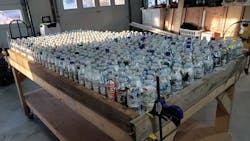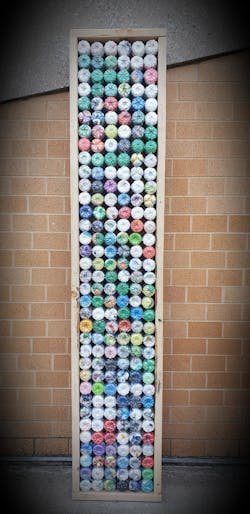By Karen Hanna
Dumpsters are a prominent feature at any building site.
But the costs of filling them — both financial and environmental — gradually occupied an even bigger role in carpenter Nathan Gray’s conscience.
Since then, he's building off the experience to explore new ways to use plastic, as an advocate for reducing trash and giving new life to waste.
“I really got to see firsthand the magnitude of waste in the industry. … It just really got me thinking about it and that’s how we switched over to building more sustainably, innovatively and affordably, using these recycled products,” Gray said.
That experience — along with the inspiration provided by having two young children — has propelled Gray in a new direction, as the founder of the House Factory Foundation is engaged in an array of nonprofit activities focused on the environment —The foundation, based in Barrington, N.H., currently is soliciting the donation of thousands of PET bottles stuffed with flexible plastic waste. Promoted as “Ecobricks” by organizations including the Global Ecobrick Alliance, bottles reinforced with plastic-waste innards can be stacked or arrayed in frames to make a variety of items, from benches to greenhouse walls. They also help people develop a better appreciation for the waste they produce, Gray said.
Gray’s group, EcoBrick US, teaches people how to make ecobricks.
“You’re collecting the plastic waste that’s coming through your household. You’re washing and cleaning it. You’re cleaning and drying it, and then you’re stuffing it into the bottle,” Gray said. “So I always joke and say that, you’ll remember when you go to the grocery store, to the hardware store, to the other local merchants that your arm will be sore.”
For stability, Ecobricks are typically packed to a density of 0.33 gram to millimeter, which works out to about 5.5 ounces of plastic for a 16-ounce bottle. Beginners can take as long as an hour to fully pack a bottle; experienced hands take about 20 minutes, Gray said.
Ecobricks have caught on in some countries that don’t have a good waste-collection system, or lack other resources, he said.
While they aren’t accepted by any building code in the U.S., Gray is experimenting with them, and plans to use them in a demonstration tiny house he’s putting up at his foundation’s headquarters.
Because the home won’t be occupied, Gray sees it as an opportunity to show off how Ecobricks might be used in the future. People will be able to see exposed layers of Ecobricks between its walls, Gray said.
Twelve thousand of them will fit between the framing of the 8-foot-by-20-foot structure, with 730 in each wall panel, illustrating how Gray believes waste plastic could be used in the future: as insulation.
“We would love to get it into the building code at some point because we need to do something with all this plastic waste,” he said. “Other areas with the plastic waste that we’re utilizing is, we’re using recycling machines to shred and extrude plastic waste. And currently, we have one-by-five molds, which, after the plastic is shredded and melted and pushed into this form, it’s used for exterior trim, just like the exterior trim that you can buy at local hardware stores and the national chain stores.”
In addition, he’s also found machinery to chop up old kayaks and used the material to create a boat launch, and he’s reclaimed single-use plastic from the pots in which plants are sold to make new planters.
Currently, he’s collecting lids and caps from people and businesses near him, experimenting with how to reuse them. And he’s looking for a bigger warehouse to store waste while he works on ways to give it new life.
“That's where my background is, in building and building innovatively, and I love to invent,” he said.
He also loves going into schools, talking to children about the environment, he said.
Motivated at first to save money, and now out of concern for the environment, Gray said he’s finding very receptive audiences for his message advocating for three R's, of reducing, reusing and recycling.
“A lot of people are waking up to the fact that plastic waste is a global crisis,” he said. “As a contractor, you could really stand out by recycling your plastic waste or buying recycled plastic waste products or reclaimed-project products.”
Karen Hanna, senior staff reporter
About the Author
Karen Hanna
Senior Staff Reporter
Senior Staff Reporter Karen Hanna covers injection molding, molds and tooling, processors, workforce and other topics, and writes features including In Other Words and Problem Solved for Plastics Machinery & Manufacturing, Plastics Recycling and The Journal of Blow Molding. She has more than 15 years of experience in daily and magazine journalism.


